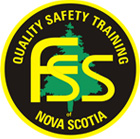Working at Heights
Hazards Identified
Falls from heights, may be vehicular traffic
Hazard-Specific Personal Protective Equipment
If needed: Fall arrest system, including full body harness and lanyard, anchor point, and life line or static line if needed
If needed: Recovery equipment
Hazard-Specific Training
If needed: Fall protection, fall arrest system, or scaffolding
Safe Work Practice
- Note that all work performed more than 3 metres above the nearest safe surface, or above a surface or thing that could cause injury to a person upon contact, requires the use of fall protection. This may be a fall arrest system which includes a full body harness, lanyard and anchor point; a guardrail, a safety net; temporary flooring; or a means of fall protection that provides a level of safety equal to or greater than a fall arrest system (Fall Protection and Scaffolding Regulations s.7).
- Before work starts, review the tasks to be completed and the fall protection system(s) to be used.
- Where traffic control is required, ensure that it is in place before work starts.
Where a fall arrest system is to be used:
- Every employee who must use a fall arrest system shall be trained in its use.
- Ensure that all necessary anchor points, lifelines and static lines are in place.
- Each component of a fall arrest system, including each lifeline, shall be inspected by a competent person prior to each use.
- A “Recovery Plan” must be developed to be used if an employee protected by the fall arrest system should fall and be suspended by the fall arrest system.
- Rescue persons shall be designated, informed as to the proper recovery procedures, trained in the use of the recovery equipment, and shall conduct regular drills.
Working at Heights (continued)
Scaffolding:
- Where scaffolding is manufactured, it must have the manufacturer’s plat attached and the manufacturer’s specifications and instructions should be readily available.
- Where in-house components are used, the scaffolding shall be certified by a professional engineer and the engineer’’ specifications and instructions should be readily available (on site).
- The erection and dismantling of every scaffold shall be supervised by a competent person.
- Every scaffold shall be inspected by a competent person each day prior to use, and if defects are observed, shall not be used until repaired or, where necessary, replaced.
- Where work is performed above water, see SWP #034, Working Over Water.
Regulations, Standards and References
Fall Protection and Scaffolding Regulations
